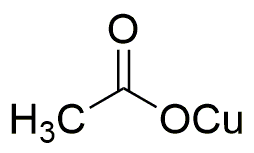Copper(I) acetate is widely utilized in research focused on:
- Catalysis: It serves as an effective catalyst in various organic reactions, enhancing reaction rates and selectivity. This is particularly beneficial in the synthesis of fine chemicals and pharmaceuticals.
- Organic Synthesis: Researchers use it in the preparation of various organic compounds, including those used in dyes and pigments, due to its ability to facilitate coupling reactions.
- Material Science: In the development of conductive polymers and nanomaterials, copper(I) acetate is employed to improve electrical properties, making it valuable in electronics and sensor applications.
- Antimicrobial Applications: Its antimicrobial properties make it useful in coatings and treatments for surfaces that require protection against bacteria and fungi, particularly in healthcare settings.
- Research in Coordination Chemistry: It is a key component in studying coordination compounds, helping researchers understand metal-ligand interactions, which is crucial for developing new materials and catalysts.
Informations générales
Propriétés
Sécurité et réglementation
Applications
Copper(I) acetate is widely utilized in research focused on:
- Catalysis: It serves as an effective catalyst in various organic reactions, enhancing reaction rates and selectivity. This is particularly beneficial in the synthesis of fine chemicals and pharmaceuticals.
- Organic Synthesis: Researchers use it in the preparation of various organic compounds, including those used in dyes and pigments, due to its ability to facilitate coupling reactions.
- Material Science: In the development of conductive polymers and nanomaterials, copper(I) acetate is employed to improve electrical properties, making it valuable in electronics and sensor applications.
- Antimicrobial Applications: Its antimicrobial properties make it useful in coatings and treatments for surfaces that require protection against bacteria and fungi, particularly in healthcare settings.
- Research in Coordination Chemistry: It is a key component in studying coordination compounds, helping researchers understand metal-ligand interactions, which is crucial for developing new materials and catalysts.
Documents
Fiches de données de sécurité (FDS)
La FDS fournit des informations de sécurité complètes sur la manipulation, le stockage et l’élimination du produit.
Spécifications du produit (PS)
Le PS fournit une description complète des propriétés du produit, notamment sa composition chimique, son état physique, sa pureté et les exigences de stockage. Il détaille également les plages de qualité acceptables et les applications prévues du produit.
Certificats d'analyse (COA)
Recherchez des certificats d'analyse (COA) en saisissant le numéro de lot du produit. Les numéros de lot et de lot se trouvent sur l'étiquette d'un produit, après les mots « Lot » ou « Lot de fabrication ».
Numéro de catalogue
Numéro de lot/série
Certificats d'origine (COO)
Ce certificat d'exploitation confirme le pays dans lequel le produit a été fabriqué, et détaille également les matériaux et composants utilisés et s'il est issu de sources naturelles, synthétiques ou autres sources spécifiques. Ce certificat peut être requis pour les douanes, le commerce et la conformité réglementaire.
Numéro de catalogue
Numéro de lot/série
Fiches de données de sécurité (FDS)
La FDS fournit des informations de sécurité complètes sur la manipulation, le stockage et l’élimination du produit.
DownloadSpécifications du produit (PS)
Le PS fournit une description complète des propriétés du produit, notamment sa composition chimique, son état physique, sa pureté et les exigences de stockage. Il détaille également les plages de qualité acceptables et les applications prévues du produit.
DownloadCertificats d'analyse (COA)
Recherchez des certificats d'analyse (COA) en saisissant le numéro de lot du produit. Les numéros de lot et de lot se trouvent sur l'étiquette d'un produit, après les mots « Lot » ou « Lot de fabrication ».
Numéro de catalogue
Numéro de lot/série
Certificats d'origine (COO)
Ce certificat d'exploitation confirme le pays dans lequel le produit a été fabriqué, et détaille également les matériaux et composants utilisés et s'il est issu de sources naturelles, synthétiques ou autres sources spécifiques. Ce certificat peut être requis pour les douanes, le commerce et la conformité réglementaire.


